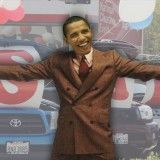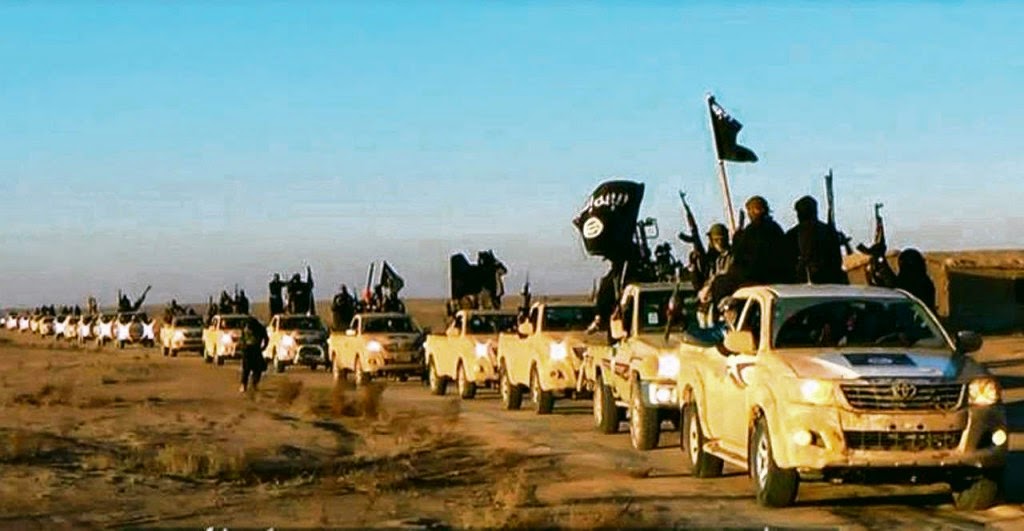Where did ISIS get all those new Toyota trucks?!
Now, at long last, U.S. counterterrorism officials have commenced an ostensibly earnest attempt to answer that open question — by asking Toyota how, exactly, ISIS came to possess such an impressive array of its late-model pick-ups and SUVs.
In response, Toyota claims to have no idea how it happened — partly because tracking vehicle sales won't necessarily catch middlemen or wholesalers with terrorist ties.
And after all, the company maintains a "strict policy to not sell vehicles to potential purchasers who may use or modify them for paramilitary or terrorist activities," according to Ed Lewis, Toyota's director of public policy and communications in Washington, as reported by ABC News. "We briefed Treasury on Toyota's supply chains in the Middle East and the procedures Toyota has in place to protect supply chain integrity."
Lewis' reference to "Treasury" is Toyota's pledge to "support" an inquiry by the U.S. Treasury Department's rather problematically-monikered Terror Financing Unit — which is one ostensible arm of a purposefully nonspecific "effort" to somehow prevent ISIS from acquiring Western stuff.
"This is a question we've been asking our neighbors," beseeched Iraqi Ambassador to the U.S., Lukman Faily. "How could these brand new trucks . . . these four-wheel drives, hundreds of them — where are they coming from?"
Toyota's Land Cruisers and its overseas version of the Tacoma — the dubious Hilux — have become a notoriously iconic feature of ISIS.
"Regrettably, the Toyota Land Cruiser and Hilux have effectively become almost part of the ISIS brand," explained Mark Wallace, CEO of the nonprofit Counter Extremism Project, which tracks and exposes financial networks that back terrorism, to ABC News. "ISIS has used these vehicles in order to engage in military-type activities, terror activities, and the like. But in nearly every ISIS video, they show a fleet — a convoy of Toyota vehicles and that's very concerning to us."
ISIS inevitably procures a bevy of U.S. military accoutrements abandoned by or otherwise wrested from Iraqi fighters, who purportedly ditched some 2,300 Humvees in retreat near Mosul — ghanimah, or spoils — a veritable boon for ISIS militants. But, as you're likely well aware, ISIS' spoils include decidedly more dangerous items than Toyotas and Humvees.
According to examples cited by Reuters, besides the Humvees, ISIS' spoils include:
- Innumerable small arms and ammunition
- 52 Howitzer M198 mobile gun systems
- 74,000 machine guns
- 40 main M1A1 battle tanks
- Unknown qty. anti-tank missiles
"It's a surreal state of affairs in which American weaponry is being sent into Iraq to destroy American weaponry previously sent into Iraq. If a new sequel to Catch-22 were to be written, this would be the plot line."
To destroy ISIS' tanks, originally sent to aid Iraqi forces, the U.S. — logically enough — proceeded to ship Iraqi forces 175 Abrams tanks; 55,000 rounds of tank ammo; $600 million in howitzers and trucks; 2,000 AT-4 rockets; and $700 million in Hellfire missiles.
Throwing money at 'it' seems to be the Department of Defense's stopgap, default answer to every issue — hence the veritable braintrust so apparent in this plan.
Brush away that trepidation, though. Should this entire shipment fall to the Islamic State, Congress already approved an additional $1.2 billion earlier this year — specifically to help bolster Iraqi forces.





Well, that explains the high demand for used Toyota trucks.